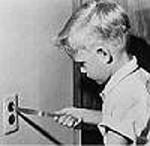absolute phase has always bothered me. if all three drivers are the same inversion, relative to the other version, and the crossover networks are essentially the same design albeit slightly different frequency rolloffs, I'm still not sure I understand why + vs - makes any difference.
Because drivers have voltage and current lags that affect the interaction with reactive components like capacitors and inductors. The result is a change in output as the frequency changes through the crossover. In actual practice the midrange and/or woofer is complementing the acoustic output of the other driver. If they are in phase in some networks they compliment too much causing a ringing effect at the crossover point.
sure, I've always assumed that crossovers use the speaker as an active element of the circuit, and are designed around the speakers natural characteristics and limitations. The extreme case is the simple 2-way crossover that consists of just a capacitor in series with the tweeter... thats relying on the natural lowpass of the woofer, and that capacitor + the tweeter's voicecoil/inductor comprise a single-pole L-C filter.
Actually the simple 2 way capacitor only design is far from extreme, it's preferred by many. The problem with a simple capacitor is not so much the response (in fact it's simplicity is a major advantage) but the lack of driver protection because too much low frequency information makes it to the tweeter. I don't like woofers run wide open this way because they make lousy tweeters and cause two point sources in the midrange. The L100 is a classic example of this and I have never liked the sound of this system because of the crossover network, or lack of one really.
I wonder if I couldn't simply add a small value resistor in series with the 035Ti to achieve some of this rolloff? Although, with my 55 yr old rock-damaged hearing, they don't sound too bright to me
 Sure, an L-pad would be better since it could control the output for the room. In the T3 versions, the shunt resistor remains 20 ohms while the series doubles to 2.4 ohms. The series capacitor changes to reflect the increased resistance seen by the 4 uf cap. If the cap was not changed the crossover frequency would drop as the total load was a little higher than before. Small detail maybe, but if you want to protect the tweeter while keeping it in the proper operating range you have to account for i
Sure, an L-pad would be better since it could control the output for the room. In the T3 versions, the shunt resistor remains 20 ohms while the series doubles to 2.4 ohms. The series capacitor changes to reflect the increased resistance seen by the 4 uf cap. If the cap was not changed the crossover frequency would drop as the total load was a little higher than before. Small detail maybe, but if you want to protect the tweeter while keeping it in the proper operating range you have to account for it.
the driver spacing is nearly identical, as are the time alignments (after all, both speakers are planar, and not stepped back like time coherent designs such as Vandersteen). Both L100T and T3 speakers have the same sharp cabinet edges, and the same impedance drivers. I know the T3 is a little deeper, and there was some conjecture on one of these threads that it was a little sturdier (I'd love to see some actual evidence of this, as when I first saw the T3 in a store a couple years after buying my T, I got a distinct impression it was a little cheaper construction, the cabinet felt lighter).
anyways, thanks for the analysis.






 Reply With Quote
Reply With Quote
 When I bought them, circa 1988(?), I took 5 CDs to about a dozen audio parlors and auditioned the a specific track off each disk on each system I was interested in in the $1000-2000 range. The L100T was the first and last system I listened to, and I bought them based on what I'd heard. I think I paid $800 for the as-new demonstrators in this small audio store in my town, after having been to all these fancy places in/around Silicon Valley, listening to Klipsch, Kefs, and all manner of $2000 speakers what I can't remember.
When I bought them, circa 1988(?), I took 5 CDs to about a dozen audio parlors and auditioned the a specific track off each disk on each system I was interested in in the $1000-2000 range. The L100T was the first and last system I listened to, and I bought them based on what I'd heard. I think I paid $800 for the as-new demonstrators in this small audio store in my town, after having been to all these fancy places in/around Silicon Valley, listening to Klipsch, Kefs, and all manner of $2000 speakers what I can't remember.

 and I have to say, having owned L100T's before, that I totally agree with the above. Any of you out there with L100T's should definitely think about doing this upgrade. You won't be sorry.
and I have to say, having owned L100T's before, that I totally agree with the above. Any of you out there with L100T's should definitely think about doing this upgrade. You won't be sorry.
